Welcome to the most spontaneous blog ever. My name is Nestor Mendez, I'm 17 and 3/4, I hope to share as must of my life as I can for the sake of your entertainment. As of right now, I'm a dual enrolled student currently attending FSW and Lehigh Senior High School. Here is one quote I live by "Hatred stirs up strife, but love covers all offenses". - King Solomon
Don't wanna be here? Send us removal request.
Text
The "Moral-Festo" Manifesto.
It's in the name, Moral. If there is anything that decides how a person holds themselves and their beliefs, it is measured by their morality. This also translates to art in unimaginable ways. Throughout this entire blog you will find analysis of all kinds of artistic pieces and videos with abstract designs and intents. One thing that seems to stick to them all, is their ability to convey sometime of action that can be deemed right or wrong depending on whose eyes they are being seen from. You could say that this pattern was derived from my choice of art, but non the less it ties in nicely. Aside from what is right or wrong, most of the pieces displayed here have artistic backgrounds that make them into the juggernaut of paintings and works of art that they are. The categories of works shown here are photos, paintings, and videos all with detailed analysis.
The paintings section of my blog features three main paintings that very accurately represent the theme of morality, even if it is subliminal. Those three paintings are The Last Judgment by Michelangelo, Yosemite IV by Natvar Bhavsar, and finally The Last Supper by Leonardo de Vinci. I would say that it is fairly obvious to say where we can see the morality aspect in the first and second painting considering that "The Last Supper" has Jesus in it, and "The Last Judgment" have some type of God like figure to it. Because both are filled with a God, we see how they all could be subjected to judgment, where the people's actions will be questioned on their morality with the way the paints show intense feelings of power in them. Now the second picture by Bhavsar is really one that you have to look into and question, how can simple strips and blend of colors reflect any sense of right or wrong? The trick is all in the colors. The blend of white, yellow, and orange in the dark shade are dark colors insinuate that there is no light. Colors like those can give off feelings of past sorrow and when these feelings come around, they make you question what could have been done to make me feel like this? That same question is one of regret from a decision that wasn't morally correct and didn't settle well in your heart. The author has a very good way on showing emotion in emotionless things.
The video section of my blog is the shows and even stronger sense of the theme. The two main videos are the "Re-Enactment" by Francis Alys and Rafael Ortega", and a small scene from "Hamlet". The first video that we see is the reenactment. The reenactment is the pinnacle of morality because of the video's realistic and suspenseful atmosphere that is creates. We can actually see in real time how one man's choices had repercussions and then how they were dealt with. There are two aspects of morality with this video, the first one is relating to the man's actions and the second to the polices. My personal opinion is that that neither where in the wrong, but one cause panic. The best part about this video is that its whole purpose was to show how much you can get out of it without having plot or continuous episodes, and that's what it achieved. The last video is hamlet. This one is very self-explanatory, there were loads of killings, but where they justified. I would say that most of them weren't, but this led to the scene becoming that much more impactful and worrisome.
With all sections of the blog covered, I hope you delight yourself with a plethora of emotions and moral decision.
0 notes
Text
Ekphrasis on "The Last Supper" from Module 2
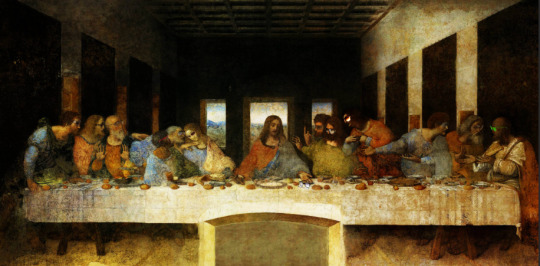
Scene: At the Dinner table, moments before the Passover Celebration.
"Peter... John, are the preparations for the Passover feast done," said Jesus after he had instructed them to follow a man and ask for permission to use the guest chamber. 'Yes rabbi, everything happened exactly as you said it would." After hearing this Jesus was very pleased and when the time arrived, he sat down with all twelve of his disciples and said, “With desire I have desired to eat this Passover with you before I suffer; for I say unto you, I will not anymore eat thereof until it be fulfilled in the Kingdom of God.” The disciples didn't know this, but Jesus was foreseeing his soon to come crucifixion. His disciples were very worried, and Andrew asked, "Why mustn't you feast of the bread no longer rabbi"; and before he could finish Jesus said, " worry not, for there is bigger anguish to be heeded." He continued and said " Very truly I say unto you, one of you who eateth with Me shall betray Me.” Everyone was filled with great sorrow, and Judas knowing it was him asked Jesus " Lord, is it I". Jesus replied, “It is one of the twelve that dippeth with Me in the dish." A couple moments after Jesus broke bread and pour wine unto his disciples and said to do this in remembrance of him and they went unto Mount Olive singing hymns.
Justification: The Visual piece that I chose was "The Last Supper" by Leonardo da Vinci. I chose this for two reasons: I saw it on module two and had been very interested in the drawing in comparison to what the actual scripture says, and because I find the life of Jesus quite interesting. One of the key details in this image is the fact that all of the disciples look troubled. This piece of information led me to focus a good amount of the dialogue on Jesus telling them about the betrayal. When I was creating the ekphrasis used some referenced from the "King James" of the 21st century bible to mimic some of the old English used, this would be the closest to what they actually spoke considering they spoke in Hebrew and Aramaic. The new interpretation that I brought is that I filled in the events that the bible doesn't cover. Adding my own little twist, moments like how the disciples felt and small talk was all added by me to add to the emotion of the words being said. Overall, I had a great deal of fun making this ekphrasis and breaking down this picture further.
450 words.
0 notes
Text
Not Seen on TV - Nestor Mendez

The video I decided to analyze was "Re-Enactment" by Francis Alys and Rafael Ortega. This video is a reenactment of a video record back in year 2000 of a man who purchased a 9mm Beretta from a store and left, walking all over town with it loaded. The man was followed by what appeared to be his friend recording him on a handy Cam Sony, then later he was arrest by the police with little to no hesitation. This side-by-side video of its original and its reenactment convey meaning and idea without telling a story. Unlike modern television that constantly speak throughout a video to develop plot, this one gives a short intro and an abstract then plays the entire video without narration. This video is taking a stance on what seems to be the police department enforcing their probable cause authority. Not a single word was said, yet the police immediately charged him an arrested him. This video is very different from paintings or even poetry because in a way it gives of uneasy feelings of suspense. Our concision plays a part in this because we see with our own eyes that this man has a loaded gun in public and can easily let it rain. Finally, I piece could expand this know-how because it a clear tutorial on how to get arrested. As a side note, I would like to add that even though this video doesn't expand on an idea or topic it has a complete though and accomplishes its goal of informing or even terrorizing, because I was very spooked as I indulged in this video.
0 notes
Text
Tragedy Scripted and Staged- Hamilt
The scene that i decided to go with was Act 4 Scene 1
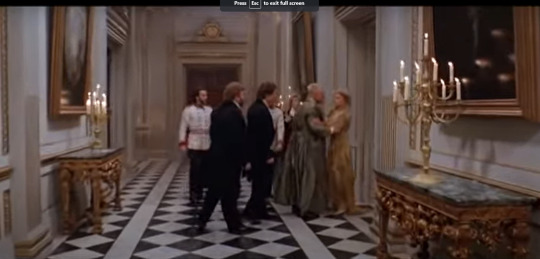
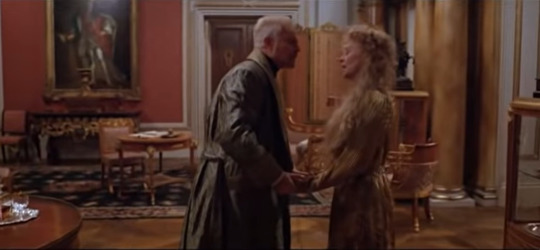
This scene takes place in one of the many rooms of the castle. Shakespeare's language use in here is like non other in the sense that rather than asking her how she is doing or what is wrong he says, "There's matter in these sighs, these profound heaves: You must translate: 'tis fit we understand them," he emphasizes on the action of her breathing. A couple of seconds later the queen dismisses everyone else in the room with just a simple "Bestow this place on us", this shows how gracefully the character enter and exeunt scenes and the turn of phrase is amazing. Shortly after, starts the dialogue between Gerturde and Claudius about Hamlet's slaying of Polonius. Gerturde had seen the scenario go down, and when ask she describe it his actions as "Mad as the sea and wind when they both content" meaning with great force and anger trying to overpower each other. She later said the Hamlet kills the man hidden behind the curtain because he is startled shouting, "A rat, a rat". There is so much good language use and plot development but the last one that I want to focus on is when they are going to dicuss with their friends about the issue and they Claudius says "Whose whisper o'er the world's diameter, As level as the cannon to his blank, Transports his poison'd shot, may miss our name." This is some very intelligent way to phrase words, and at first it is challenging to understand what he is saying, but he is referring to the bad look all over the world this can have on him, and he is hoping that it will miss and not affect him. After seeing the 1996vacting of the scene, the characters all come to live in an incredible way. In the reading the characters seem a bit stationary, but in the acting Claudius was all over several rooms and halls unlike the script which says one room.
0 notes
Text
Photographer's Eye Topic: relationships take time.
Youth Alive
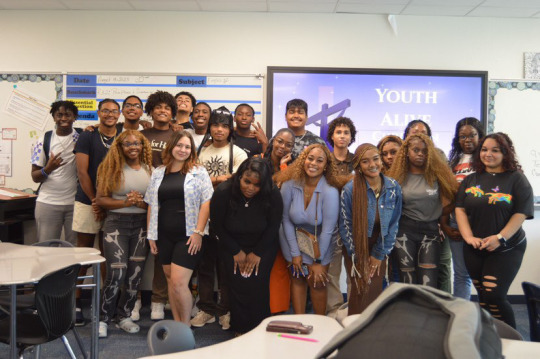
This is the club me and my good friend started. At first, we had nobody but now we have a constant 30 members.
2. Co-workers

At first, I'd never see myself being friends with my co-workers, but who knew what time could do to us.
3. My mother and I

My and my mother never got along well, but after I found myself that allowed for us to get a closer and tighter relationship.
4. My best friend and I
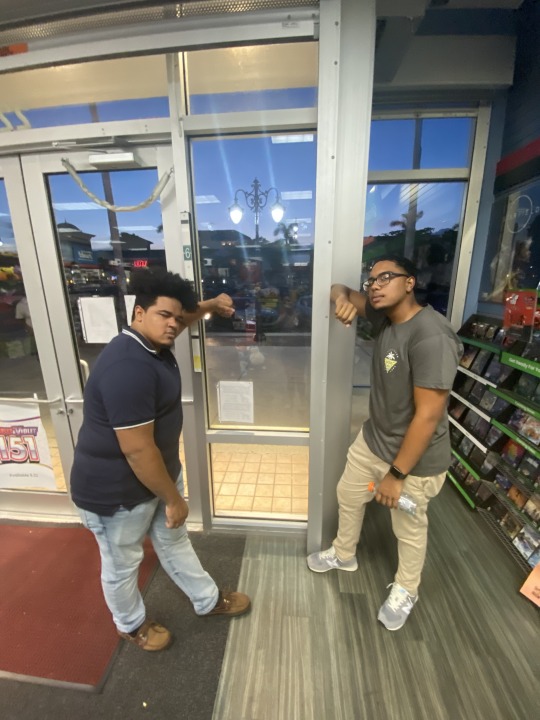
I never believed in best friends, always thought it was a myth until I had met this guy on the right. It didn't happen right away; it took 2 years of battling with issues.
5. Me, My self, and I

Out of all of this is the most important one because it is the relationship you have with yourself that is going to take the longest out of all of them to build up because it is everlasting as you mature and grow. Without this one you can't have any of the other ones.
In conclusion, the whole point of this was to show that nothing good in life comes easy. These are all good times because you can see all of us smiling and having a good time. The interesting part is that none of that happened from one day to another, but that it had taken months and months of trial an error to build up something beltful of relationships in other people. Just like real ships, they take you for a joy ride through ups and downs. Building strong and meaningful relationships is a process that often takes time, patience, and effort. Whether it's forming bonds with friends, family, or romantic partners, the journey will never be an easy one. Overcoming conflicts and challenges is another part of relationship-building that takes time. Disagreements are inevitable, and it's how individuals navigate and resolve these conflicts that determines the strength of a relationship. If there is one thing to take away is that relationships are always ongoing.
0 notes
Text
Short Fictional Story - Nestor Mendez
November 9th would me the day that would mark my life forever. On this day I decided to cut all my hair(situation). I did it to become like the rest and have a more popular look on myself. Some back story, I'm the number one running back in the nation with offers to all types of college and institutions, you name it! I thought the only thing that could make me even better is a sick haircut. I went from having long luscious hair with tight defended curls that would cover my elbows from the back and still have an afro affect because of the thickness to the hair; to just a mid-taper with a blowout. The new hair style looked amazing, but I could feel something was wrong. The instant I got up out the barber's chair I fell to my knees, I could figure out why, but I felt weak(change). Everyone else in the barber shop thought I was being dramatic considering I was known all around as the class clown. Later that evening I began to feel a change, almost as if I was shrinking in size, weight, and physique. I look in the mirror and looked like a malnourished version of myself, and the moment I noticed this it all came back to me. I remember that when I was born a special rain fell over me and I heard a whisper say, "It all lies in the hair". I now regret it all, wish I could go back to my former self. All the clothes, fame, money, offers, they would all dissipate in the blink of an eye(sittuation B). This felt surreal and I just could shake the fact that I would never ever be the same from now one, so I now take this as a warning to never cut my hair, "oh and did I mention November 9th was the day I had this dream"?
0 notes
Text
Love Poem Analysis - Nestor Mendez
Love by Tina Chang | Poetry Foundation
This poem uses a lot of figurative language and rhetorical devices, but in simple words, it speaks about love. Not the love you find that comes and goes, but a love than can only be given from the birth giver, a love so profound that nothing can rival it, a love that conquers all. Throughout the poem the author would explain the things that her mother would do for her because she loved her, such as peeling every last bit of a grape until it was completely fleshless. The protagonist is the daughter, and she gives of a nostalgic feeling because we were all kids once and we all have those memories of our mother caring for us. The author uses an interesting metaphor: If I were a dream, you could say my countenance was a string of flickering lights made of teeth or an expression unraveling like a carpet into a narrow river of another life." This gives of feelings of a surreal experience being unfolded through life. I believe that throughout the entire essay this has a central image of our moms nurturing us as babies, even if we are grown it still applies because some way or another, she still takes care of us, showing a motherly love.
0 notes
Text
Architectural Interiors - Nestor Mendez
Architectural Interiors are often misunderstood for the contents in the building, but today I come to write about a domestic architectural interior that I'm very familiar with. To no surprise, that will be my own home. When I say home, I am referring to the walls that make up the living space, not the property in whole or the things around it. When we look at the body or the perimeter that encompasses the border of my house, we see it is made up of two large rectangles, one bigger than the other. They are positioned almost in a "T" shape except for the they are touching each other horizontally. A "T" has one horizontal line and one vertical in the center, imagine that but the smaller rectangle in place of the vertical line. There is a divide between where these two rectangles touch to separate the house from the lanai. With in the house part, there are several divides that a space for rooms like the kitchen, bedrooms, bathrooms, and living rooms, all with the purpose of providing a domestic environment for me and my family to live in. The way the house is built allows for both areas of light and dark with the lanai and windows being the main source of light. All of these things allow for this space to be comfortable and unique.
Now an architectural Interior that I inhabit and enjoy inhabiting a lot is the gym. There is nothing to special about the gym considering it is just a large rectangle with a high ceiling. This building has minimal spaces that divide it for spaces like bathrooms and privacy rooms. Compared to my home, this place is more active, and I have a lot of fun in it because of how spacious it is. On the flip side, my domestic home is more "homey" and I'd prefer my house because its structure is one that meets my demands on having a roof over my head. Regardless of their differences they both complete their purposes in difference ways.
0 notes
Text
Downtown Fort Myers' "Allure Your Senses" Sculpture Analysis - Nestor Mendez
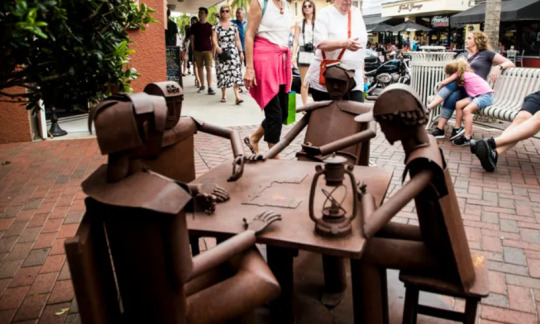
(The first sculpture is about 4 feet tall, with a width and length of 5 feet)
What you are looking at right here is one out of 23 wonderfully sculpted statues found in Downtown Fort Myers called "Allure Your Sense". The sculptor of this piece goes by the name of Edgardo Carmona, and they made their debut on January 7th, 2016. The initial motive for commissioning these works were for an exhibit. As the sculptures started to gain traction, the public soon wanted to keep them, and they were bought for $55,000 dollars to be a staple of Downtown Fort Myers.
This sculpture main purpose of this sculpture is to preserve the history of the Calusa Indians. Carmona treasures history, and he wanted to represent the struggles of the city in its initial stages. The community values these pieces of art because they are hot spots for socializing and can even spark a conversation. This sculpture resonates in the mind of many citizens because they are found in the same streets the amazing men like Thomas Edison and Henry Ford walked; in fact, this very same work of art can be found outside of the restaurant "Ford's Garage".

(The second is about 19ft tall, has a width and length of about 4ft including the base)
As you look at these next few pictures of two more sculptures from the "Allure Your Sense", you can really start to notice a pattern between them, and why the sculpture chose it to be this way. The surrounding area you see the rest of these sculptures and they are all performing some sort of act, or form of entertainment. Carmona's drive to preserve history led me to believe that the Calusa Indias where very optimistic and playful even in the mist of their situation. x
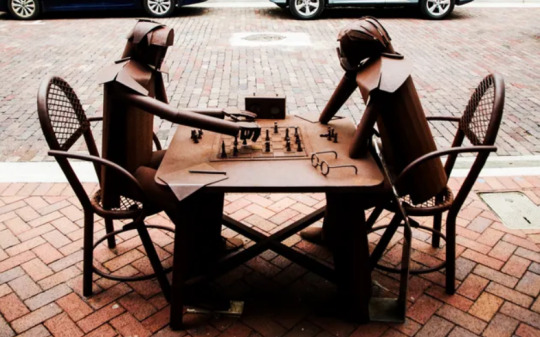
(The third sculpture is about 4ft tall, and was a width of about 6ft and a length of about 4ft)
0 notes
Text
Abstract Image - Yosemite IV by Natvar Bhavsar - Analyzed by Nestor Mendez
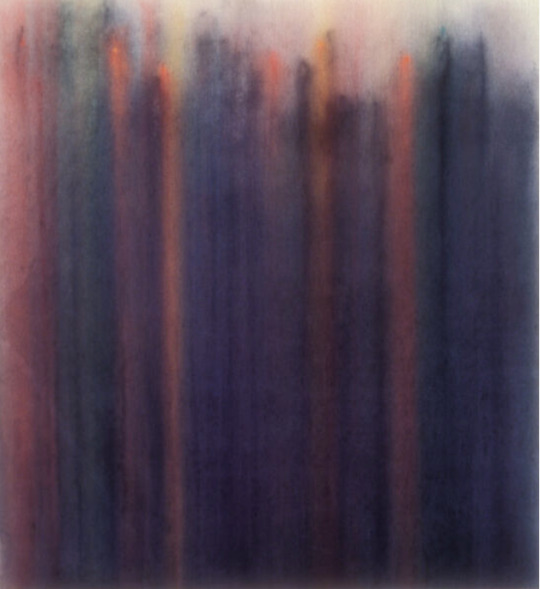
This is Yosemite IV, a painting by Natvar Bhavsar painted in the 1980.
This is one amongst many abstract paintings that illustrate nothing but mean so much. This painting's dull looks connotate more than just randomness and is the pinnacle of "Don't judge a book by its cover". As we look at this picture, we can make out a number of what seems to be different colored vertical lines in different thicknesses; all fading out at the very top. The selection of color is very interesting because we can see bright colors like white, yellow, and orange, but they are all in the dark shade. The painting looks like it feels soft or humid, which would make sense since it looks like the it was painting using watercolors. This shapeless painting seems to be in a shadow of its own. The dark colors insinuate that there is no light, whilst at the very top the white seems to fade out the colors making it look like a shadow of a shadow.
The lack of sharpness in the lines give of a feeling of sadness and lost hope; on top of that, there is an abundant amount of dark blue giving of feelings of past sorrow. The more I look at this picture the more I think about what I could've done better in my past. This painting gives off a sense of reflection and self-evaluation that if seen at the right time, could bring someone to tears. Natvar Bhavsar's paint revealed to be that I could always do better.
My initial thoughts on picking this image were brought up because of its randomness, but now I see that it isn't so random. When looking at this image you can see that the artist really poured out his spirit during the painting process. To conclude, I can say that I'm in awe at the message this painting paints and does a better job of communicating feelings than words themselves.
1 note
·
View note
Text
The Last Judgment (1541) by Michelangelo - Break Down from Nestor Mendez
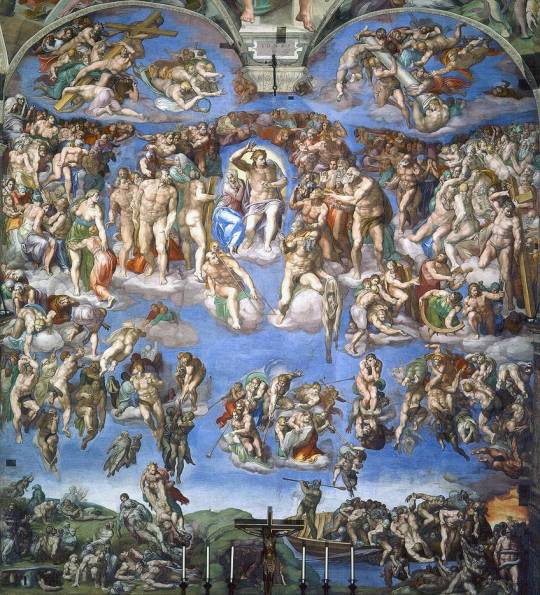
This is "The Last Judgment" by Michelangelo and it takes up the complete wall of the Sistine Chapel. The painting took Michelangelo around four years to complete, and it was even changed later on because of its nudity. This painting is interesting in many ways because of its vast amount of detail that went into it. The first thing that caught my eye was Jesus crucified at the cross in Golgotha. Then as we make our way up with our eyes, we notice a figured that seems to be surrounded by many people or angels, almost as if he was the focal point. Not only that, but we see a divided in the painting; almost as if there were three parts or maybe even four: the earth/land, the sky, the heavens, and maybe even eternal damnation in the bottom left corner. I also noticed that every divide has its ruler or main character except for hell in the bottom left corner. This painting speaks to me so vividly that I could have a conversation with it. The painting is trying to convey that there are a lot of "battles" going on in the earth section of the painting like Jesus dying, fires, people drowning etc... On the contrary, we can see that the painting towards the upper half is calmer and relaxing with a lot more people gathered around. Assuming the top half is heaven, I feel like this painting is trying to tell us that we will have many afflictions in this world, but there's always something better to look forward to.
2 notes
·
View notes
Text
FRIST POST!!! BLOG GOING STRONG
Stay tune for the next post!!
2 notes
·
View notes